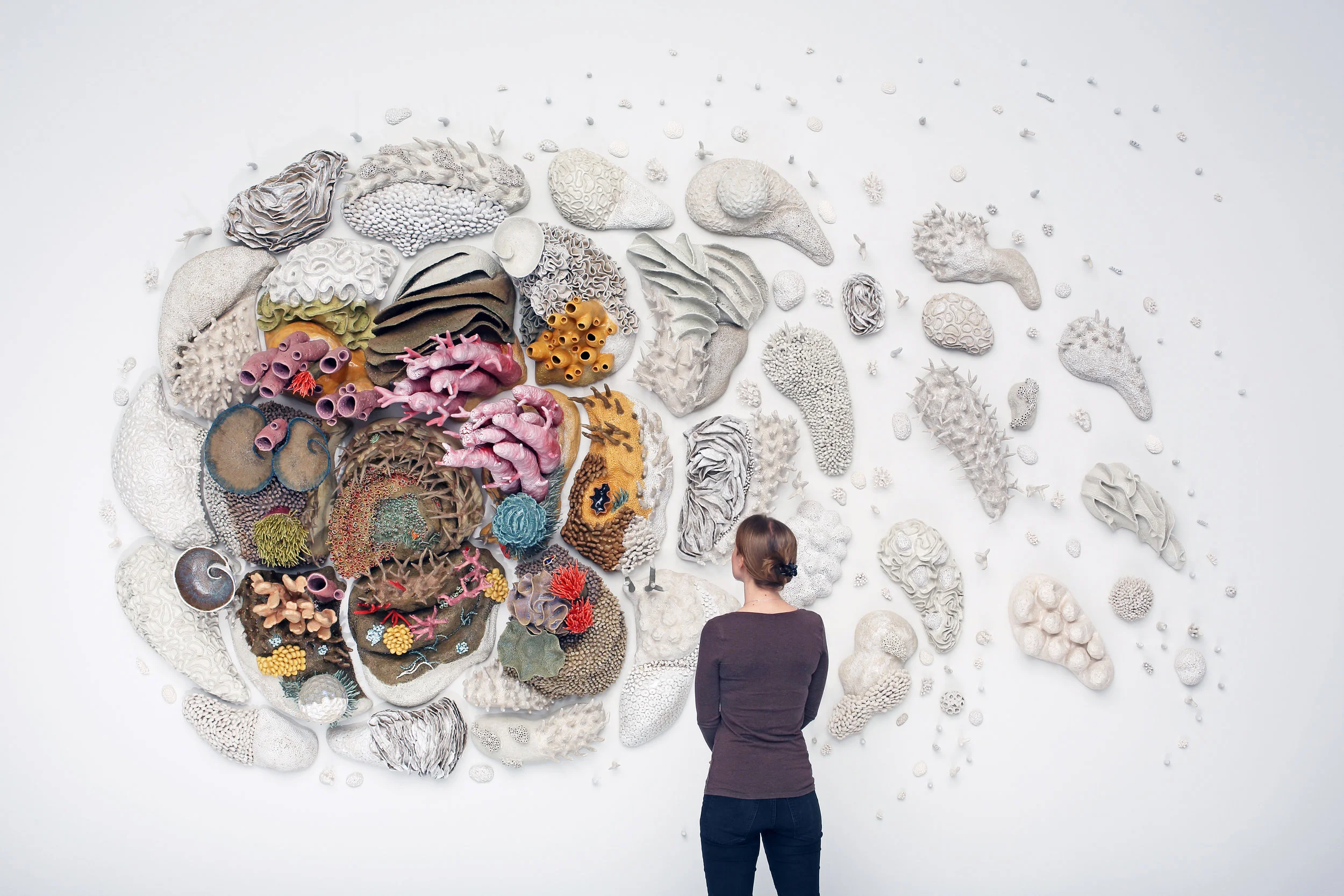"by reducing the other threats we impose on the ocean, we can help give reefs a better shot at surviving in a warming world."
We sat down with Courtney Mattison, ceramic sculptor and ocean advocate
August 12, 2019
Confluence (Our Changing Seas IV) by Courtney Mattison. Courtesy of Art in Embassies, U.S. Department of State Permanent Collection for U.S. Embassy Jakarta. Photo by Amanda Brooks.
Q: Why is bringing the issue of climate change to your artwork so important to you?
A: The concept of climate change is nebulous to so many, partly because it is difficult to see. You can’t easily watch carbon dioxide or other greenhouse gases floating into the air, creating a sort of thermal blanket around our planet that keeps solar energy from leaving our atmosphere. And corals, which are extremely sensitive to these changes, provide an amazingly stark visualization of climate change by becoming sick and “bleaching.” The goal of my work is to bring the beauty and peril of coral reefs above the surface and into view to inspire policy makers and the public to protect them while we still can.
Photo by Amanda Cotton
Q: When and how did you fall in love with coral reefs?
A: Coral reefs have captivated my imagination for as long as I can remember. I love reefs for the mysteries they hold and for the tiny plant-like animals that are the faceless architects of some of the world’s largest living things. I fell in love with them in person as a college student on a semester abroad at James Cook University in Townsville, Australia in 2007. For about eight months, I spent as much time as I could diving on the outer barrier reef and being dazzled by the exuberance of life out there. But as I was falling in love, I was heartbroken to learn of the ominous impacts of climate change, ocean acidification, overfishing and pollution. Understanding that something as exquisite and otherworldly as the Great Barrier Reef could be deteriorating so rapidly because of human activities motivated me to dedicate my life’s work to inspiring people to care and act to prevent these impacts.
Photo by Courtney Mattison
Q: Your exhibit Our Changing Seas was featured at the US embassy in Indonesia, can you tell us a little about that experience?
A: The US Department of State’s Office of Art in Embassies commissioned me to create Confluence (Our Changing Seas V) for the permanent collection of the new US Embassy in Jakarta, Indonesia. It’s an enormous work and my largest one yet, with 404 individually hand-sculpted and glazed ceramic corals swirling down a wall space about 28 feet tall by 18 feet wide and protruding nearly two feet. This site-specific installation celebrates the fragile beauty, diversity and value of Indonesia’s vibrant reefs while highlighting the anthropogenic impacts of climate change. After deriving inspiration from Indonesia’s reefs for over a decade, it’s an honor for me to dedicate this work to those who are uniting to fight climate change and conserve reefs of Indonesia and around the world.
Photo by Arthur Evans
Q: What are 3 ways people can help save coral reefs?
A: The biggest threat to coral reefs, and the ocean as a whole, is climate change. We must drastically slow down greenhouse gas emissions if we have a hope of seeing coral reefs persist in some functional form past our lifetimes. It can feel like climate change is too big of an issue for each of us to make a difference in solving. It isn’t easy, but it’s actually quite simple:
VOTE: for policy makers and policies that support renewable energy and regulate emissions.
Vote with your money as a consumer: Support businesses and lifestyle choices that reduce emissions and other forms of pollution – like Samudra Skin & Sea. Their Body Butter is great to keep in my studio to moisturize my dry clay hands!
Be mindful: of what you consume, what you throw away, what you take out of the environment and what you put into it. Learn what foods are more climate friendly, refuse plastic whenever possible, and use biodegradable products like reef-safe sunscreen. By reducing the other threats we impose on the ocean, we can help give reefs a better shot at surviving in a warming world.
Photo by David Decoteau
Follow Courtney on Instagram @courtneycoral and see more of her stunning work at courtneymattison.com




